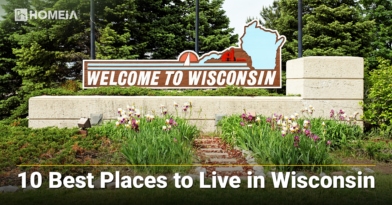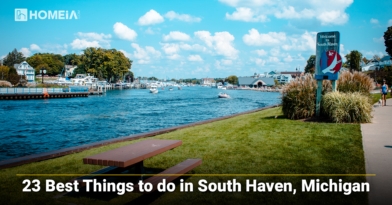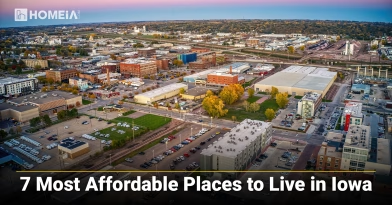7 Key Factors to Know About Living in Milwaukee, Wisconsin
- Local Editor:Local Editor: The HOMEiA Team
Published: Jun 14, 2023
- Category: City Living Guide
Living in Wisconsin is affordable for many people who want a reasonable cost of living place. If you want the variety, history, and entertainment options of a big city, but with shorter commutes and a laid-back Midwestern vibe, Milwaukee, WI may be the place for you.
It has an upscale side, especially in trendy districts like the Historic Third Ward, and its proximity to Chicago helps to attract exceptional entertainment and dining options, while its rural surroundings keep it grounded.
Here’re 7 Key Things You Should Know Before Moving to Milwaukee, WI.
Table of Contents:
- HOMEiA Score: Our Methodology
- 1. Lifestyle in Milwaukee
- 2. The Cost of Living in Milwaukee, WI
- 3. Home Price in Milwaukee
- 4. Safety & Health Care
- 5. Employment
- 6. Education in Milwaukee, WI
- 7. Climate in Milwaukee
- Frequently Asked Questions Before Moving to Milwaukee:
- Is Milwaukee a good place to live?
- What are the main pros and cons of living in Milwaukee?
- Is Milwaukee an affordable place to live?
- What is the lifestyle in Milwaukee?
- Is Milwaukee a dog-friendly city?
- How many dogs can you have in the city of Milwaukee?
- Does Milwaukee have nightlife?
- What is the best school district in Milwaukee?
HOMEiA Score: Our Methodology
Our Methodologies to create HOMEiA Score Ratings for Each Group of Content
HOMEiA uses a consistent, data-driven methodology to evaluate U.S. states for livability, affordability, and long-term value. Our analysis centers on key factors such as Housing and Affordability, Cost of Daily Living, Access and Infrastructure, Community Strength, Safety and Quality of Life, Economic Resilience and Job Market…
1. Lifestyle in Milwaukee

Milwaukee is the largest city in Wisconsin, with around 600,000 residents in the city itself and roughly 1.6 million in the wider metro area. Its architecture and neighborhoods flaunt its history, from its industrial roots to its historic influx of German, Polish, Italian, and Irish immigrants.
It’s a city that loves its sports, beer, festivals, and music, and local culture ranges from the refined (like the architecturally impressive Milwaukee Art Museum on the shore of Lake Michigan) to the down-home (like the traditional Friday fish fry).
Bolstered by its central location and high-volume international airport, Milwaukee attracts a constant stream of new ideas and opportunities.
2. The Cost of Living in Milwaukee, WI

One of the great things about living in Milwaukee is that you get all the benefits while spending less than you would in most big cities in the United States. It means the cost of living in Milwaukee, WI is cheaper than the US average.
Affordable housing is one of the main factors. Unlike Minneapolis and Chicago, Milwaukee boasts rent and home prices under the national average, and it beats the national index for goods and services, groceries, and utilities, too.
Average commute times of 22 minutes keep transportation costs low for most residents, and food costs compare well to those in the Northeast and the West.
One area where you’ll pay more in Milwaukee is health care, but it’s not all bad news. You’ll get more for the money, as Wisconsin is widely considered to have high-quality health systems.
MIT’s Living Wage Calculator, which estimates how much individuals would have to earn to support themselves in a given geographical area, indicates that a single adult can get by on around $24,000 per year in Milwaukee, and a family with two working adults and two kids would need about $62,000.
Compare that to similarly-sized Portland, Oregon, where you’d need $30,000 for a single adult and over $75,000 for two kids with childcare to have the same quality of life. Milwaukee is a bargain!
5 Most Affordable and Safe Places to Live in Wisconsin
Whether you are seeking waterfront views, vibrant city life, or peaceful small-town charm, Wisconsin provides affordable, safe options for individuals, families, and retirees. From the banks of The Mighty Mississippi to the shores of Lake Michigan, from the beaches of Lake Superior to…
3. Home Price in Milwaukee

Home costs in Milwaukee are one of the main reasons that the city is so affordable. According to the Wisconsin Realtors Association, the median home price in Milwaukee County was around $160,000 at the end of 2019, about 86% of the statewide median price; both are well below the national rate.
Buying a house at that price (with 10% down, a 30-year mortgage, and around 4% interest) would cost about $894 per month—barely $50 over the median gross rental payment. Taking equity into account, that makes home ownership in Milwaukee a pretty good deal.
There’s something for everyone here. If you want to be near all the action, explore the high-rise condo buildings downtown. Some will even give you a stunning lake view. If you prefer plenty of space, you’ll find large properties and spacious newer homes in the suburbs.
Recommended for you
4. Safety & Health Care

Is Wisconsin a good place to live? The answer is Yes. If health care quality matters to you (and it surely does!), you will be pleased to know that Wisconsin is often ranked among the top few states. The Agency for Healthcare Research and Quality scored Wisconsin fourth among all states in its 2018 report, and top among all states in the Midwest.
The state rated in the top category (“Very Strong”) in a number of crucial areas, including acute care and hospital care as well as treatment for cardiovascular and chronic kidney disease.
The Milwaukee area is a leader in research and medical training, home to both the Milwaukee Regional Medical Center (which includes the Blood Research Institute) and the Medical College of Wisconsin. Children’s Hospital of Wisconsin is nationally ranked in nine pediatric specialties by US News and World Report.
Advocate Aurora Health is the largest health care system in the metro area, and other options include Ascension Health, Froedtert Health, and ProHealth Care.
In the 2019 Downtown Milwaukee Perceptions Report, most respondents reported that they generally feel safe spending time downtown.
The Pros and Cons of Living in Wisconsin
Wisconsin offers diverse living options for everyone, from emerging professionals, to growing families, to good-living retirees. With its affordable cost of living, natural beauty, and strong communities, the Badger State is definitely an attractive option for relocation. Whether you prefer urban amenities in Milwaukee and Madison or the tranquil settings of Door County and the Northwoods, Wisconsin provides something for every lifestyle…
5. Employment

MarketWatch lists Milwaukee in its top 20 U.S. metro areas for business, and Inc. magazine calls the region one of the 25 best places to do business. The metro area’s biggest employers include Aurora Health Care, Ascension Wisconsin, Froedtert Health, Kroger Co./Roundy’s, Kohl’s Corp., and Quad/Graphics, Inc.
It is the headquarters for S.C. Johnson and for Fortune 1000 companies such as Northwestern Mutual, ManpowerGroup, Kohl’s, WEC Energy, Rockwell Automation, Fiserv, and Harley-Davidson.
About 277,000 people are employed in Milwaukee. The largest industries include health care and social assistance, manufacturing, and retail. The highest-paid include finance and insurance; utilities; and professional, scientific, and technical services. Many people who work in the city are in production, office/administrative support, or sales-related roles.
Recommended for you
6. Education in Milwaukee, WI

If you have children, you’ll be happy to know that the Milwaukee Public School district offers 159 school options, serving 74,633 students. The district includes five of U.S. News & World Report’s 2019 Top High Schools. Private schools offer an alternative to the public system, and the broader Milwaukee has around 100 of them.
A number of postsecondary schools are located in Milwaukee, most notably the University of Wisconsin-Milwaukee, with an enrollment of about 24,000 students, and the private Marquette University, a Jesuit Catholic college with about 12,000 students. Milwaukee Area Technical College offers opportunities for the whole city, whether full-time, part-time, or just taking an evening class.
10 Best Places to Live in Wisconsin
Wisconsin is a friendly and casual place to enjoy all four seasons. Best known for its dairy farms and pro sports, it is also home to tech companies and a world-class research university. We assign a HOMEiA Score for each city, which provides an overall assessment of its safety and appeal as a place to call home…
7. Climate in Milwaukee

The summers in Milwaukee can be beautiful, if a bit muggy. Average high temperatures peak in July around 80 degrees, but highs can easily climb into the 90s, and the record is 105. June is the rainiest month, averaging 3.5 inches.
In the winter, average temperature lows dip to 18 degrees in January, and weather forecasts in the winter often feature negative numbers. On the coldest days—the kind that close schools—temps may fall to minus 10 degrees or colder, and the wind chill can be much lower than that. Snowfall varies widely year to year, but may average around 40 inches.
While folks from some states fear the cold, Milwaukeeans take pride in their resilience and ability to enjoy the full range of seasons. They get a big laugh out of seeing warm cities shut down over a dusting of snow!
To sum up, Milwaukee has something for everyone, whether your tastes run high-end or low-brow. As long as you appreciate beer and cheer for the Brewers, this community will suit you (and if you don’t, just prepare for some good-natured ribbing).
There’s always something to do here, especially in summer months when the calendar is full of festivals (including Summerfest, billed as the world’s largest) and the State Fair (try the cream puffs!). It’s the best of the Midwest with an urban twist.
23 Best Things to do in South Haven, Michigan
Michigan may be most known for Detroit and the automobile industry, but the state is much more. With 3,288 miles along the Great Lakes, it has the longest freshwater coast in the entire country. With so much coastline, there are bound to be many vacation communities nestled along the lake…
Frequently Asked Questions Before Moving to Milwaukee:
Living in Milwaukee, Wisconsin, may come with various questions and considerations. Here are some frequently asked questions (FAQs) that people often have when moving to or living in Milwaukee:
Is Milwaukee a good place to live?
Yes! Milwaukee is a great place to live. However, whether Milwaukee is a good place to live also depends on individual preferences and priorities. Milwaukee offers a unique blend of attributes that can be appealing to many people, but it may not be the ideal fit for everyone. Here are some factors to consider when evaluating whether Milwaukee is a good place to live:
Cost of Living: Milwaukee generally has a lower cost of living compared to larger cities like Chicago or New York. Housing is relatively affordable, and the cost of goods and services is reasonable.
Job Opportunities: Milwaukee is home to a diverse economy with strong sectors in manufacturing, healthcare, finance, and technology. Job opportunities are available in various industries.
Culture and Entertainment: Milwaukee has a vibrant cultural scene with numerous museums, theaters, music festivals, and sports events. It’s known for its beer and brewing culture, as well as its lively music and food scenes.
Education: The city has a range of educational institutions, including universities and colleges, offering diverse academic opportunities.
Outdoor Activities: Milwaukee is located on Lake Michigan and offers opportunities for outdoor activities such as sailing, hiking, and biking. There are also many parks and recreational areas within the city.
Diversity: Milwaukee is a diverse city with various ethnic communities and cultural events, contributing to a rich tapestry of experiences.
Safety: While Milwaukee has its safe neighborhoods, it also has areas with higher crime rates. Researching specific neighborhoods is essential to find a safe and comfortable place to live.
Weather: Milwaukee experiences all four seasons, with cold winters and warm summers. Some people may love the seasonal changes, while others may find the winters challenging.
Commute: Consider your commute to work or other essential places, as traffic and public transportation options can vary across neighborhoods.
Community and Lifestyle: Your satisfaction with living in Milwaukee may also depend on the sense of community you find and whether the city’s lifestyle aligns with your interests and values.
Ultimately, whether Milwaukee is a good place to live depends on your personal preferences, lifestyle, and priorities. It’s a city with a lot to offer, but it’s important to thoroughly research and visit the area to determine if it aligns with your needs and expectations.
3 Most Affordable Neighborhoods to Live in Sterling Heights, Michigan
This article explores three of the most affordable neighborhoods in Sterling Heights, highlighting their distinctive features, amenities and overall livability for prospective residents…
What are the main pros and cons of living in Milwaukee?
Living in Milwaukee, like any city, comes with its own set of pros and cons. These can vary depending on individual preferences and priorities. Here are some of the main pros and cons of living in Milwaukee:
Pros of Living in Milwaukee:
Affordable Cost of Living: Milwaukee generally has a lower cost of living compared to many other major cities in the United States, making it more affordable for housing, groceries, and other expenses.
Job Opportunities: The city has a diverse economy with opportunities in manufacturing, healthcare, finance, technology, and more. It’s also known for its strong job market.
Cultural Scene: Milwaukee offers a rich cultural experience with numerous museums, theaters, music festivals, and art galleries. It’s particularly renowned for its music, beer, and food scenes.
Education: Milwaukee has a range of educational institutions, including universities and colleges, offering diverse academic opportunities.
Lake Michigan: The city’s location on Lake Michigan provides access to beautiful lakeside parks, beaches, and recreational activities like sailing, fishing, and biking.
Diverse Communities: Milwaukee is home to various ethnic communities, contributing to a culturally diverse and inclusive atmosphere.
Sports Enthusiasts: If you’re a sports fan, Milwaukee has professional sports teams like the Milwaukee Bucks (NBA) and Milwaukee Brewers (MLB), offering entertainment options year-round.
Friendly Residents: Milwaukee is often described as a friendly and welcoming city, with a strong sense of community.
3 Most Affordable and Safe Neighborhoods to Live in Detroit, Michigan
Detroit’s metropolitan area offers diverse options for those seeking affordability without compromising safety. New Center stands out with its rich history and vibrant community, while Bagley offers historic charm with strong community ties. Rivertown demonstrates Detroit’s urban renewal with waterfront living and downtown access…
Cons of Living in Milwaukee:
Harsh Winters: Milwaukee experiences cold and snowy winters, which can be challenging for those not accustomed to winter weather.
Crime Rates: While there are safe neighborhoods, some areas of Milwaukee have higher crime rates. Researching neighborhoods is essential for finding a secure place to live.
Traffic Congestion: Like many urban areas, Milwaukee can experience traffic congestion during rush hours.
Public Transportation: The public transportation system, primarily consisting of buses, may not be as extensive or reliable as in some larger cities.
Limited Public Schools: The quality of public schools can vary, and some residents opt for private or charter schools.
Seasonal Tourism: During the summer, an influx of tourists can lead to crowded areas and increased traffic in popular neighborhoods.
Healthcare: While Milwaukee has healthcare facilities, some residents may need to travel to larger cities for specialized medical care.
Economic Disparities: Milwaukee faces economic disparities, with some neighborhoods having limited access to economic opportunities and resources.
Ultimately, the decision to live in Milwaukee should be based on your personal priorities and preferences. It’s essential to research specific neighborhoods and consider your lifestyle, career goals, and tolerance for weather conditions when evaluating whether Milwaukee is the right place for you.
5 Most Affordable and Safe Places to Live in Michigan
Michigan offers a wealth of affordable, safe communities with distinct characteristics and amenities. From waterfront charm in Traverse City to academic vibrancy in East Lansing, these five cities demonstrate the diverse lifestyle options available throughout the Great Lakes State…
Is Milwaukee an affordable place to live?
Yes! Milwaukee is an affordable place for living and working. Milwaukee, Wisconsin, was generally considered an affordable place to live compared to many other major U.S. cities. However, affordability can vary significantly depending on your individual circumstances and what you’re comparing it to. Here are some factors to consider:
Housing Costs: Milwaukee’s housing costs were generally lower than those in cities like New York, San Francisco, or Los Angeles. Rent and home prices were relatively reasonable, especially in comparison to larger metropolitan areas.
Cost of Living: The overall cost of living in Milwaukee was lower than in many other major cities, with affordable groceries, transportation, and healthcare. However, costs can vary depending on your lifestyle and needs.
Income Levels: Income levels in Milwaukee were also lower than in some larger cities. This can impact your perception of affordability, as it’s important to consider both income and expenses when evaluating a city’s affordability.
Property Taxes: Wisconsin generally has higher property taxes compared to the national average. Property tax rates can vary within Milwaukee County and may affect your overall living costs if you own a home.
Utilities and Transportation: Utility costs and public transportation options in Milwaukee were typically reasonable, which can help make the city more affordable.
Income and Job Opportunities: It’s crucial to consider your income potential and job opportunities in Milwaukee, as these factors can greatly affect your ability to afford living there.
Please keep in mind that economic conditions can change over time, and factors such as housing markets, job markets, and cost of living can evolve. I recommend checking more recent sources, like local cost of living indices and job market reports, to get the most up-to-date information about the affordability of living in Milwaukee in 2023. Additionally, your individual financial situation and lifestyle preferences will play a significant role in determining whether Milwaukee is affordable for you.
Top 5 Best Places to Live in Michigan
The state of Michigan has a city for everyone, whether you want a college vibe, metro urban environment, or to conclude your day with a dazzling sunset over a freshwater ocean. Michigan boasts over 90 colleges and universities and Michiganders are never more than six miles from a body of water. Sound like a great place to live? I agree! While so many cities…
What is the lifestyle in Milwaukee?
Milwaukee, Wisconsin, offers a diverse and vibrant lifestyle that caters to a wide range of interests and preferences. Here are some aspects of the lifestyle in Milwaukee:
Outdoor Activities: Milwaukee boasts a beautiful location along the shores of Lake Michigan, providing plenty of opportunities for outdoor enthusiasts. You can enjoy activities like sailing, kayaking, biking along the lakefront, and exploring nearby parks and nature trails.
Arts and Culture: Milwaukee has a thriving arts and cultural scene. The city is home to various museums, including the Milwaukee Art Museum and the Harley-Davidson Museum. You can also explore galleries, theaters, and music venues hosting a variety of performances and events.
Sports: Milwaukee has a passionate sports culture, with professional teams like the Milwaukee Bucks (NBA), Milwaukee Brewers (MLB), and Milwaukee Admirals (AHL). Attending games and supporting the local teams is a significant part of the city’s lifestyle.
Food and Dining: Milwaukee offers a diverse culinary scene, with a focus on German, Polish, and other European cuisines due to its immigrant heritage. The city is known for its cheese and beer, and you can find numerous breweries and restaurants serving local craft beers and delicious food.
Festivals: Milwaukee is often referred to as the “City of Festivals” because it hosts numerous festivals throughout the year. The most famous is Summerfest, one of the world’s largest music festivals. Other festivals celebrate cultural diversity, food, and the arts.
Music and Nightlife: The city has a lively nightlife with a variety of bars, clubs, and music venues. You can find everything from jazz and blues clubs to dance clubs and live music performances.
Education: Milwaukee has several universities and colleges, including the University of Wisconsin-Milwaukee and Marquette University, providing educational and cultural opportunities.
Family-Friendly: Milwaukee offers family-friendly attractions like the Milwaukee County Zoo, Betty Brinn Children’s Museum, and Discovery World Science and Technology Center, making it a suitable place to raise a family.
Community and Neighborhoods: The city’s neighborhoods each have their own unique character, from historic areas like the Third Ward to more suburban settings in the surrounding suburbs. The choice of where to live can greatly impact your lifestyle.
Seasonal Activities: Milwaukee experiences all four seasons, allowing for a variety of seasonal activities, including winter sports, fall foliage drives, and summer festivals on the lakefront.
Milwaukee’s lifestyle is characterized by its friendly residents, cultural diversity, and a strong sense of community. While it may not have the same bustling pace as some larger cities, it offers a balanced mix of urban amenities and outdoor recreation opportunities, making it an appealing place to live for many people.
What to Know About Parking in Chicago, Illinois
Drivers need to know which options are available, what the rules and regulations say about parking, and where to go when traveling with a car. Knowing these things will mitigate any potential issues that arise. Luckily, Chicago has many options for people who know where to look…
Is Milwaukee a dog-friendly city?
Yes, Milwaukee is generally considered a dog-friendly city. The city and its surrounding areas offer a variety of amenities and opportunities for dogs and their owners to enjoy. Here are some reasons why Milwaukee is known as a dog-friendly city:
Dog Parks: Milwaukee has several dog parks where dogs can run off-leash and socialize with other dogs. Examples include Estabrook Park Dog Exercise Area, Granville Dog Park, and Runway Dog Exercise Area at Mitchell Airport.
Pet-Friendly Accommodations: Many hotels and accommodations in Milwaukee are pet-friendly, allowing visitors to bring their dogs along for their stay.
Outdoor Activities: Milwaukee’s parks and trails provide opportunities for dog owners to go for walks, hikes, and outdoor adventures with their pets. The city’s proximity to Lake Michigan also offers waterfront walks and recreational activities.
Pet Services: There are numerous pet services in Milwaukee, including grooming salons, pet boutiques, and veterinarians, to cater to the needs of dogs and other pets.
Dog-Friendly Events: Milwaukee hosts various dog-friendly events and activities throughout the year, such as Barktoberfest, Paws & Claws Gala, and dog-friendly charity walks.
Dining with Dogs: Some restaurants in Milwaukee have outdoor seating areas that welcome dogs, making it possible for you to dine out with your furry friend.
Pet-Friendly Culture: Milwaukee’s residents tend to be pet-friendly and often participate in community events that involve pets. It’s not uncommon to see people walking their dogs in various neighborhoods.
While Milwaukee is generally dog-friendly, it’s important for dog owners to be responsible and follow local ordinances and rules related to dogs, such as leash laws and waste cleanup requirements. Additionally, individual businesses may have their own policies regarding dogs, so it’s a good idea to check in advance if you plan to bring your dog to a specific location or event.
The 5 Best Places to Live in Illinois: A City Comparison
Illinois blends world-class cities, small-town charm, and rich farmland, offering diverse lifestyles across the Prairie State. This guide highlights the five best Illinois cities to live in 2025, based on affordability, opportunity, safety, and quality of life—from Chicago’s vibrancy to Urbana-Champaign’s academic appeal in the heart of the Midwest.
How many dogs can you have in the city of Milwaukee?
Milwaukee allows up to 5 pets with a permit. the city of Milwaukee had regulations in place regarding the number of dogs a person or household can own, but these regulations can change over time. In Milwaukee, the specific rules governing the number of dogs you can have may vary depending on the zoning regulations for your particular neighborhood. Zoning codes can dictate the number of dogs allowed and whether a kennel license is required for multiple dogs.
It’s important to note that local ordinances and regulations can change, so it’s crucial to check with the City of Milwaukee’s Department of Neighborhood Services or visit their official website for the most up-to-date information on dog ownership regulations, including any changes that may have occurred until recent time.
Additionally, some neighborhood associations or homeowners’ associations within the city may have their own rules regarding pet ownership, so it’s advisable to check with them as well if you live in a specific neighborhood with such restrictions. It’s essential to comply with local regulations to ensure a harmonious living environment and avoid any potential legal issues related to pet ownership.
7 Most Affordable Places to Live in Iowa (updated)
Iowa offers more than farmland and friendly faces—it’s one of the most affordable states to call home. With low housing costs and a stable economy, it’s ideal for families, retirees, and remote workers. This guide highlights seven budget-friendly Iowa communities for 2025, balancing cost, comfort, and Midwestern charm.
Does Milwaukee have nightlife?
Yes it does! Milwaukee has a nightlife scene that offers a variety of entertainment options for residents and visitors. While it may not have the same level of nightlife as some larger cities, it still provides a lively and diverse nightlife experience. Here are some aspects of Milwaukee’s nightlife:
Bars and Breweries: Milwaukee is famous for its brewing heritage, and you can find numerous bars, brewpubs, and breweries throughout the city. You can explore craft beer offerings and enjoy local brews in a relaxed atmosphere.
Nightclubs: There are several nightclubs and dance venues in Milwaukee where you can enjoy music and dancing. These venues often feature DJs and live music, catering to different musical tastes.
Live Music: Milwaukee has a thriving live music scene, with venues that host a wide range of musical genres, from jazz and blues to rock and hip-hop. The city’s music festivals, like Summerfest, also showcase both local and national acts.
Restaurants and Eateries: Many restaurants in Milwaukee offer late-night dining options, making it possible to enjoy a meal after an evening out. Some places also have outdoor patios and rooftop bars for a unique nightlife experience.
Comedy Clubs: Comedy clubs provide entertainment and laughter with stand-up comedy performances. Milwaukee has venues where you can enjoy a night of comedy with friends.
Cultural Events: Milwaukee hosts various cultural events and arts performances in the evening, including theater productions, art exhibitions, and cultural festivals.
Sports Bars: If you’re a sports enthusiast, you can find sports bars in Milwaukee where you can watch games and matches on big screens while enjoying food and drinks.
Late-Night Activities: Some venues stay open late into the night, allowing you to continue your night out into the early hours of the morning.
The nightlife scene in Milwaukee tends to be more relaxed and less crowded than in larger cities, creating a friendly and welcoming atmosphere. While it may not be known for its flashy club scene, it offers a variety of options for those looking to unwind, socialize, and have a good time in the evening. Keep in mind that the specific venues and their popularity can change, so it’s a good idea to check for the latest information and events when planning a night out in Milwaukee.
7 Factors Rank Minneapolis as one of the Best Cities in Minnesota
It is well known as one of the Twin Cities, sharing that moniker with another of the oldest cities in the state: St. Paul. These cities originally served as home to Native Americans along the Mississippi River and later grew as centers for river trade, logging and four mills. This…
What is the best school district in Milwaukee?
Determining the “best” school district in Milwaukee can be subjective and dependent on your specific needs and preferences. Milwaukee has several school districts, each with its own strengths and challenges. When evaluating school districts in the Milwaukee area, consider factors such as academic performance, extracurricular activities, resources, and the overall educational experience. Here are a few school districts in the Milwaukee area that are often recognized for their quality:
Whitefish Bay School District: Whitefish Bay is a suburb of Milwaukee known for its highly regarded school district. The district consistently performs well academically, with strong support from the community.
Elmbrook School District: Located just west of Milwaukee, the Elmbrook School District is one of the largest and most highly rated districts in the state of Wisconsin. It has a reputation for academic excellence and offers a wide range of extracurricular activities.
Mequon-Thiensville School District: Another suburban district north of Milwaukee, Mequon-Thiensville, is known for its strong academic programs, excellent teachers, and community involvement.
Shorewood School District: The Shorewood School District, located in the village of Shorewood, is known for its high-quality education and community engagement. It has a tradition of strong academic performance.
Wauwatosa School District: Wauwatosa is a suburb of Milwaukee with a well-regarded school district. It offers a variety of educational programs, including International Baccalaureate (IB) options.
Fox Point-Bayside School District: This small district north of Milwaukee is known for its quality education and small class sizes, which can provide a more personalized learning experience.
Keep in mind that the best school district for your family will depend on your individual needs, including your child’s grade level, interests, and any specific educational requirements. It’s advisable to research each district thoroughly, visit schools, and speak with parents and educators to make an informed decision about the best fit for your child’s education. Additionally, school district rankings and reputations can change over time, so it’s essential to check for the most recent information and reviews when making your decision.
8 Best Cities for Buying a House and Raising a Family in Minnesota
While everyone in Minnesota shares accesses to the great outdoors, four distinctly enjoyable seasons, and a friendly Midwestern vibe, each community has its own personality. Here are our views of the Top 8 Cities for family life in Minnesota. With a variety of personalities and attractions…
Table of Contents:
- HOMEiA Score: Our Methodology
- 1. Lifestyle in Milwaukee
- 2. The Cost of Living in Milwaukee, WI
- 3. Home Price in Milwaukee
- 4. Safety & Health Care
- 5. Employment
- 6. Education in Milwaukee, WI
- 7. Climate in Milwaukee
- Frequently Asked Questions Before Moving to Milwaukee:
- Is Milwaukee a good place to live?
- What are the main pros and cons of living in Milwaukee?
- Is Milwaukee an affordable place to live?
- What is the lifestyle in Milwaukee?
- Is Milwaukee a dog-friendly city?
- How many dogs can you have in the city of Milwaukee?
- Does Milwaukee have nightlife?
- What is the best school district in Milwaukee?
HOMEiA is a city guide site where visitors can find detailed information about communities of interest. HOMEiA’s City Guides, created in partnership with local writers and editors, are curated lists of the best, safest, and most affordable places to live. The guides feature the HOMEiA Score, a proprietary index that rates communities on such factors as housing costs, education, employment, etc.
HOMEiA.com aims to be the premier site for people planning to relocate, providing them with insightful content and connecting them with skilled real estate professionals.
We also empower real estate professionals to establish or strengthen their web presence by highlighting their experience, knowledge and achievements. If you’re selected to join our list of certified real estate professionals, you will distinguish yourself from your peers — and earn HOMEiA’s support.
If you believe in HOMEiA’s mission, please share our website with others.
Table of Contents:
- HOMEiA Score: Our Methodology
- 1. Lifestyle in Milwaukee
- 2. The Cost of Living in Milwaukee, WI
- 3. Home Price in Milwaukee
- 4. Safety & Health Care
- 5. Employment
- 6. Education in Milwaukee, WI
- 7. Climate in Milwaukee
- Frequently Asked Questions Before Moving to Milwaukee:
- Is Milwaukee a good place to live?
- What are the main pros and cons of living in Milwaukee?
- Is Milwaukee an affordable place to live?
- What is the lifestyle in Milwaukee?
- Is Milwaukee a dog-friendly city?
- How many dogs can you have in the city of Milwaukee?
- Does Milwaukee have nightlife?
- What is the best school district in Milwaukee?












































































































































































































